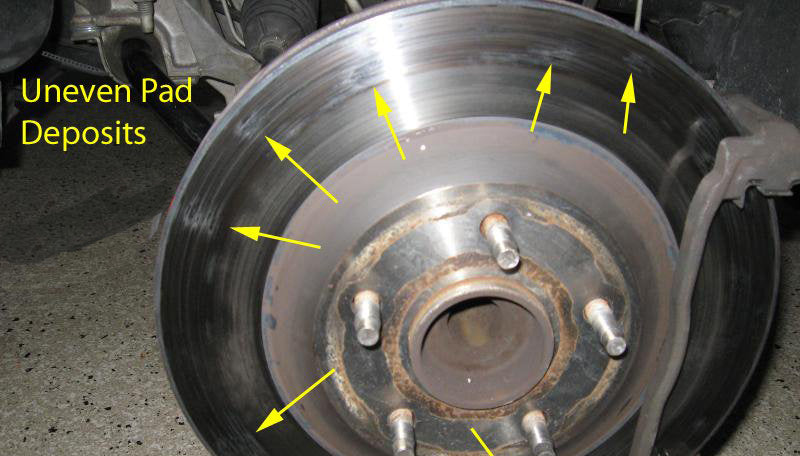Brake pulsation can be a troubling issue for many drivers. It affects the smoothness of your ride and can indicate underlying problems.
When you press the brake pedal and feel a vibration or pulsation, it’s often a sign that something isn’t right. This sensation can be alarming and impact your vehicle’s safety. Brake pulsation can be caused by a variety of factors, and understanding these causes is crucial for proper vehicle maintenance.
In this blog post, we will explore the common reasons behind brake pulsation. Knowing these causes can help you take the necessary steps to fix the issue and ensure a safer driving experience. So, let’s dive into the main reasons why your brakes might be pulsating.

Credit: www.youtube.com
Common Brake Pulsation Symptoms
Brake pulsation can be a serious concern for vehicle owners. It affects the overall braking performance and safety. Recognizing the symptoms early can help in addressing the issue promptly. Here are some common symptoms of brake pulsation:
Shaking Steering Wheel
One of the most noticeable symptoms is a shaking steering wheel. When you apply the brakes, you might feel the steering wheel vibrate or shake. This often points to an issue with the front brakes. It can be caused by warped brake rotors or uneven brake pad wear.
To better understand, consider these common signs:
- Steering wheel shakes only during braking.
- Vibration intensity increases with speed.
- Shakes more when braking downhill.
Vibrating Brake Pedal
Another clear symptom is a vibrating brake pedal. When you press the brake pedal, it should feel smooth. If it vibrates or pulsates, there might be a problem with the rear brakes. This can also be due to issues like warped rotors or uneven pad wear.
Look out for these signs:
- Pedal vibrates under your foot during braking.
- Vibration is more noticeable at higher speeds.
- Pedal feels spongy or less responsive.
Recognizing these symptoms can help in diagnosing and fixing brake pulsation issues early. Ensuring your brakes are in good condition is crucial for safe driving.

Credit: springworks.com
Warped Brake Rotors
Brake pulsation can occur due to a variety of reasons, but one common cause is warped brake rotors. Warped rotors can lead to uneven braking and vibrations felt through the brake pedal. Understanding the causes of warped rotors can help prevent this issue and ensure a smooth driving experience.
Heat Buildup
One major cause of warped brake rotors is heat buildup. When braking, friction generates heat. If the brakes overheat, the rotors can warp. This happens especially during heavy braking or when driving down steep hills. The excessive heat causes the metal to expand and warp.
Here are some factors contributing to heat buildup:
- Frequent hard braking
- Continuous braking on steep descents
- Heavy loads or towing
To avoid this, use lower gears on descents and allow brakes to cool between heavy uses.
Improper Wheel Installation
Improper wheel installation is another culprit for warped brake rotors. When wheels are not mounted correctly, it can cause uneven pressure on the rotors. This uneven pressure leads to warping over time. Ensuring proper installation can prevent this issue.
Proper wheel installation includes:
- Using a torque wrench to tighten lug nuts
- Following the manufacturer’s torque specifications
- Ensuring even tightening in a crisscross pattern
By following these steps, you can maintain even pressure and prevent rotor warping.
Brake Pad Issues
Brake pulsation can be a significant issue for drivers. One common cause of this problem is brake pad issues. Understanding these issues can help you diagnose and fix brake pulsation. In this section, we’ll explore two primary brake pad problems: uneven pad wear and contaminated pads.
Uneven Pad Wear
Uneven pad wear happens when brake pads wear down unevenly. This issue can cause brake pulsation. Various factors contribute to this problem. Poor installation, misalignment, or defective brake components are common culprits. Regularly checking and maintaining your brake pads can prevent uneven wear.
Contaminated Pads
Contaminated pads are another cause of brake pulsation. Brake pads can become contaminated with oil, grease, or road debris. These contaminants reduce the effectiveness of the pads. This contamination can lead to uneven braking and pulsation. Cleaning or replacing contaminated pads can solve the issue.

Credit: www.reddit.com
Loose Wheel Bearings
Loose wheel bearings can lead to brake pulsation. This can create a wobbly or vibrating sensation when braking. Understanding this issue helps in maintaining vehicle safety and performance.
Causes Of Loose Bearings
Several factors can contribute to loose wheel bearings. These causes include:
- Wear and Tear: Bearings wear down over time, leading to looseness.
- Poor Installation: Incorrect installation can leave bearings not secured properly.
- Improper Lubrication: Lack of grease or oil can increase friction, causing wear.
- Environmental Factors: Dirt, water, and debris can contaminate bearings, leading to failure.
Detection Methods
Detecting loose wheel bearings early can prevent further damage. Here are some methods to identify loose bearings:
- Visual Inspection: Look for grease leakage or visible damage around the wheel hub.
- Listen for Noises: Grinding or humming sounds can indicate bearing issues.
- Feel for Vibration: When driving, check for unusual vibrations or wobbling.
- Wheel Movement Test: Jack up the car and wiggle the wheel. Excessive movement indicates loose bearings.
Regular inspection and maintenance can help detect loose bearings early. This ensures a safer and smoother driving experience.
Suspension Problems
Experiencing brake pulsation can be frustrating and dangerous. One significant cause often overlooked is suspension problems. The suspension system connects the vehicle to its wheels, ensuring smooth rides. If it malfunctions, it can lead to brake pulsation. Here, we delve into two main suspension-related issues: worn-out components and alignment problems.
Worn Out Components
Suspension parts wear out over time. Bushings, ball joints, and control arms are crucial. When they degrade, the vehicle loses stability. This instability can cause the brakes to pulsate.
To identify worn-out components, look for these signs:
- Excessive vibration during braking
- Unusual noises from the suspension
- Uneven tire wear
Regular inspection helps in early detection. Replace faulty parts promptly to avoid brake issues.
Alignment Issues
Proper alignment ensures that the wheels point in the right direction. Misalignment can lead to uneven braking. This causes the brake pedal to pulsate.
Signs of alignment issues include:
- Vehicle pulling to one side
- Steering wheel vibration
- Uneven tire wear
Regular wheel alignment checks are essential. Correct alignment improves braking performance. It also ensures a smooth driving experience.
Addressing these suspension problems can help eliminate brake pulsation. Always maintain your vehicle’s suspension system for better safety and performance.
Fixing Brake Pulsation
Brake pulsation can make your driving experience uncomfortable. Fixing brake pulsation ensures smooth rides and safety. Below are two methods to address this issue.
Rotor Resurfacing
Resurfacing the rotors can help fix brake pulsation. Over time, rotors can become uneven. This uneven surface causes vibrations when braking. Rotor resurfacing smooths the surface. It removes minor grooves and imperfections. The process involves removing a thin layer of the rotor. Specialized machinery is used for this. A smooth rotor ensures even contact with brake pads.
Not all rotors can be resurfaced. Check the rotor thickness before starting. If too thin, replacement is necessary. Resurfaced rotors extend the life of your braking system.
Replacing Brake Pads
Worn brake pads can also cause pulsation. Replacing them can solve the issue. Brake pads wear down with use. Thin pads may not contact the rotor evenly. This uneven contact causes vibrations. New pads provide uniform contact. They ensure consistent braking performance.
Choose high-quality brake pads for better results. Replace both front or both rear pads together. This ensures balanced braking. Regularly check your brake pads. Timely replacement prevents further issues.
Preventive Maintenance Tips
Preventing brake pulsation is crucial for a smooth and safe driving experience. Regular maintenance can help you avoid costly repairs and ensure your vehicle’s brakes perform at their best. Below are some key preventive maintenance tips:
Regular Inspections
Conducting regular inspections of your braking system can catch issues early. Check the brake pads, rotors, and calipers for any signs of wear or damage. Look for the following:
- Uneven wear on brake pads
- Cracks or grooves in the rotors
- Leaking brake fluid
- Corrosion on brake components
By identifying problems early, you can prevent minor issues from becoming major repairs. Make it a habit to inspect your brakes at least once a month.
Proper Installation Techniques
Ensuring proper installation of brake components is vital. Incorrect installation can lead to brake pulsation and other issues. Follow these tips:
- Always use the correct tools and equipment.
- Ensure all components are clean before installation.
- Tighten bolts to the manufacturer’s specifications.
- Use high-quality parts from reputable brands.
Proper installation reduces the risk of brake failure and ensures your brakes work efficiently. If you’re unsure, consult a professional mechanic.
When To Seek Professional Help
Experiencing unusual vibrations or shaking when braking? These could indicate brake pulsation issues. Seek professional help to diagnose and fix the problem.
Brake pulsation, or the shaking felt during braking, can signal serious issues. While minor issues might be fixed with basic tools, some problems need a professional’s touch. Knowing when to call in an expert can save you time and money.Signs Of Severe Damage
Severe damage often shows clear signs. If your car shakes violently when braking, it’s more than a minor issue. Loud grinding sounds point to worn-out brake pads or damaged rotors. If the brake pedal feels soft or sinks to the floor, seek help immediately. These signs indicate serious problems needing expert attention.Cost Considerations
Professional help comes with costs. Simple brake pad replacements are less expensive. Replacing damaged rotors or the entire brake system costs more. Regular maintenance can prevent costly repairs. Ignoring brake issues leads to more severe damage and higher expenses. Prioritize safety and seek professional help when needed. “`Frequently Asked Questions
What Causes Brake Pulsation?
Brake pulsation is caused by uneven rotor wear. Warped rotors or unevenly worn brake pads can also be culprits.
How Can I Fix Brake Pulsation?
Fix brake pulsation by resurfacing or replacing the brake rotors. Changing the brake pads can help too.
Is Brake Pulsation Dangerous?
Yes, brake pulsation can be dangerous. It reduces braking efficiency and can cause longer stopping distances.
Can Brake Pulsation Damage My Car?
Yes, prolonged brake pulsation can damage suspension components. It can also lead to more severe brake issues.
How Do I Prevent Brake Pulsation?
Prevent brake pulsation by maintaining your brakes. Regularly check and replace worn brake components. Avoid heavy braking.
Conclusion
Brake pulsation can be a troubling experience for drivers. It often points to issues like warped rotors or uneven wear. Regular maintenance and checks help prevent these problems. Addressing brake pulsation early ensures safer driving and extends the life of your braking system.
Always consult a professional mechanic for accurate diagnosis and repair. Understanding the causes helps you take proactive measures. Stay alert to any unusual brake sensations. Keep your brakes in top condition for a smoother, safer ride.

















